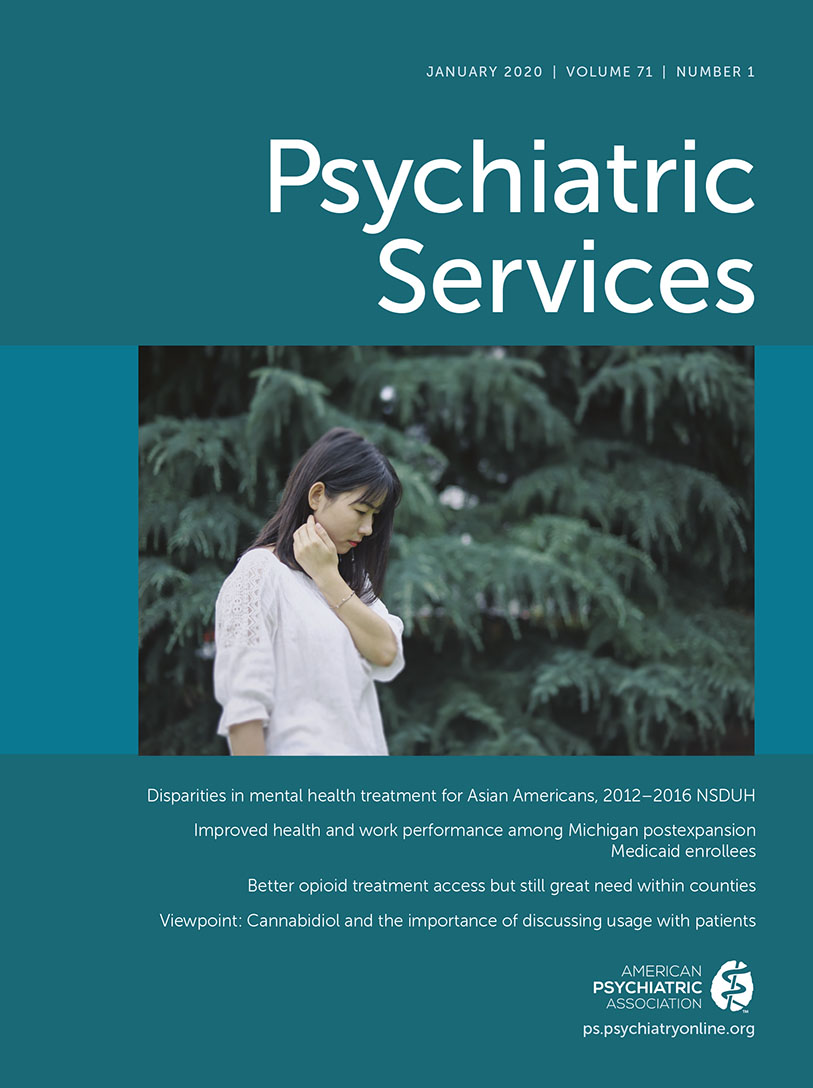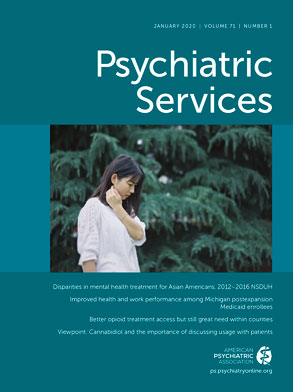Continuity of care is a critical determinant of short- and long-term health care outcomes for people receiving inpatient psychiatric care. Roughly 30%−50% of individuals admitted to hospital psychiatric units fail to attend an aftercare appointment within 30 days of discharge (
1,
2). This discontinuity of care is associated with poor outcomes, including increased risk of relapse, homelessness, suicide, and criminal justice involvement (
3–
6). Timely follow-up visits after psychiatric inpatient care have also been associated with reduced risk of readmission, although the evidence is mixed (
5–
7).
Communication by hospital mental health staff with outpatient mental health providers is a standard inpatient treatment practice that promotes continuity of care (
6,
8–
10). Olfson et al. (
11) showed that patients were significantly more likely to attend postdischarge appointments if their inpatient provider spoke with an outpatient provider prior to the patient’s discharge. Engagement in care prior to a hospital admission has also been found to be a strong predictor of continuity of care following hospital discharge (
1,
2). It is unclear whether and how engagement in care prior to admission and communication between inpatient and outpatient providers during the hospital stay interact to promote continuity of care after discharge. Given the fast pace of hospital psychiatric care and short lengths of stay, it is important to know which patients are most likely to experience improved follow-up care as a result of direct communication between inpatient and outpatient providers.
A previous study estimated that hospital psychiatric providers contacted outpatient providers to discuss treatment plans for 70% of 17,053 Medicaid recipients discharged from hospital psychiatric units, and that such discharge planning activities were associated with improved follow-up during the first 7 days after discharge (
12). In this analysis of a subset of those cases, we reviewed inpatient medical records to examine whether communication between inpatient and current or prior outpatient providers was associated with attending outpatient follow-up care among patients who had and had not received mental health care during the 30 days prior to the admission. Prior to conducting these analyses, we hypothesized that communication with outpatient providers would be significantly related to attendance at outpatient follow-up care for inpatients who were not receiving care prior to the index hospital admission but not for those who were receiving care prior to admission.
Methods
We examined Medicaid claims and closed medical records for 189 Medicaid recipients admitted to psychiatric units at two urban hospitals from 2012 to 2013. Cases were chosen from among 854 patient admissions with a primary mental health diagnosis listed at discharge and that received concurrent utilization review by a Medicaid managed care organization during the study period. We selected a total of 240 patient discharges for review (120 at each site). Cases were selected following a two-step procedure. As an initial step, and to achieve a heterogenous group with respect to discharge planning practices, we chose all cases for which the Medicaid managed care organization reported that the patient did not receive comprehensive discharge planning (e.g., inpatient staff failed to communicate with an outpatient provider, schedule an aftercare appointment, or forward a discharge summary to an aftercare provider). This accounted for 122 cases; we randomly chose the other 118 cases from among the remaining patient admissions and selected 50 additional patient admissions from each hospital for use in training the reviewers. Institutional review boards from the study research team site as well as from both hospitals approved all study procedures and granted waivers of consent allowing for retrospective review of closed medical records.
Demographic data, including age, gender, and race-ethnicity, were extracted from Medicaid claims. Clinical characteristics extracted from Medicaid claims included length of hospital stay, primary diagnosis at discharge, and presence of a co-occurring substance use disorder diagnosis as determined through claims made during the 12 months prior to admission. Data on preadmission and postdischarge use of outpatient mental health services also were obtained from Medicaid claims. Two dichotomous variables were created: one indicating whether patients had received outpatient mental health care during the 30 days prior to admission and the other indicating whether they had received outpatient mental health care during the 7 days after hospital discharge. Outpatient mental health treatment services were defined as any visit to a clinic or specialty behavioral health service licensed by the state mental health authority. The 7-day cutoff point for receipt of outpatient mental health care was chosen to parallel the Healthcare Effectiveness Data and Information Set (HEDIS) quality measure, “Follow-up After Hospitalization for Mental Illness,” which identifies 7- and 30-day follow-up percentages that are commonly used in mental health quality and performance incentive programs.
Coders used a data collection tool developed for this study to review the medical records for evidence that inpatient staff communicated with an outpatient provider, which was defined as contacting a current (at the time of admission) or prior outpatient mental or substance use disorder treatment provider and exchanging clinical information about the patient. Clinical information was defined as information regarding the patient's medical and/or clinical history or status, personal characteristics or behaviors related to the patient’s treatment for a mental or substance use disorder, circumstances leading to the current admission, or information relevant to discharge planning and postdischarge community-based care. When there was no documentation of direct communication between inpatient staff and outpatient providers, but information from an outpatient provider was included in the medical record, the case was coded as meeting the criteria for communication. For example, a record may have included documented evidence of information that was obtained by emergency department staff from an outpatient provider or may have contained documented evidence that information obtained by inpatient staff from the patient’s outpatient records influenced the treatment and/or discharge plan. After training, inter-rater reliability was tested on a subset of training records also rated by the principal investigator (T.S.) and project coordinator (M.H.). Interrater reliability for identifying evidence of communication between inpatient staff and an outpatient provider was satisfactory (k=0.77). Coding was performed blinded to the postdischarge outpatient follow-up status.
We used bivariate analyses to examine associations between communication among inpatient staff and outpatient providers and patient demographic and clinical characteristics with attendance at an outpatient appointment within 7 days of discharge. We then used logistic regression models to examine associations between inpatient staff communication with an outpatient provider and patient attendance at an outpatient appointment within 7 days of discharge while we controlled for all other variables. We created separate logistic regression models for two subgroups: patients who had and had not received outpatient mental health care in the 30 days prior to admission.
Results
From among the original 240 cases available for review, the final sample included 189 unique psychiatric inpatients: 93 from hospital A and 86 from hospital B. Hospital inpatient staff communicated with an outpatient treatment provider for 118 (62%) of the patients discharged, and 99 patients (52%) attended a mental health outpatient visit within 7 days after discharge. Bivariate analyses indicated significantly higher proportions of attendance at outpatient mental health care within 7 days of discharge for patients who did (N=53 of 85, 62%), compared with those who did not (N=46 of 104, 44%), receive outpatient mental health care during the 30 days prior to admission (odds ratio [OR]=2.09; 95% confidence interval [CI]=1.16–3.75). Seven-day postdischarge follow-up attendance was also significantly higher for patients for whom the inpatient staff communicated with an outpatient provider during the admission (N=71 of 99, 60%), compared with patients for whom staff did not communicate with an outpatient provider (N=28 of 99, 39%) (OR=2.32, 95% CI=1.27–4.24). Seven-day postdischarge follow-up attendance was also significantly higher for white (N=41 of 99, 62%) compared with black (N=36 of 99, 43%) patients (OR=2.14, 95% CI=1.11–4.14). Descriptive data and analyses for the full population are available in the online supplement.
Table 1 shows demographic and clinical characteristics for the patients who did (N=85) and did not (N=104) receive outpatient mental health services during the 30 days prior to admission. Separate logistic regression models adjusted for all covariates were fit for both groups. Among patients who had received outpatient mental health services in the 30 days prior to admission, none of the covariates were related to attendance at an outpatient appointment within 7 days following discharge. Among patients who did not receive outpatient services in the 30 days prior to admission, however, communication between inpatient staff and a prior outpatient provider was independently associated with receipt of outpatient mental health care within 7 days of discharge (OR=2.73, 95% CI=1.09–6.84). No other variables were significant in this model (
Table 1).
Discussion and Conclusions
Providers completing routine discharge planning do not consistently communicate with outpatient providers (
13–
15), even though such communication is considered a standard of care. Our findings suggest that these communications may be particularly important for patients who were not attending outpatient care in the month prior to admission. In these instances, this communication may provide opportunities to help coordinate outpatient care with providers who may not be familiar with the patient’s treatment plan and the circumstances surrounding the inpatient admission. After the analyses were controlled for several potentially confounding variables, these communications were significantly associated with patient attendance at outpatient mental health follow-up care.
Limitations of this study included its small sample size, focus on only two hospitals, and the inability to measure some patient, hospital, and service system factors that may influence entering outpatient treatment after inpatient discharge. Obtaining collateral clinical information from previous providers may be nothing more than a surrogate marker for more skilled providers, better staffing of treatment teams, more cooperative patients, greater family involvement, or other factors. We also could not establish whether lack of communication reflected unavailability of providers at certain times or across certain geographic areas. Future research is needed to clarify the impact of these factors on care transitions.
Further research is also needed for hospital quality assurance programs, such as the Centers for Medicare and Medicaid Services’ Inpatient Psychiatric Facility Quality Reporting Program. Identifying specific practices, such as communication with providers, which are most likely to improve patient outcomes, can inform selection of measures for these programs and ensure meaningful incentives. The findings reported herein suggest that encouraging hospital staff to communicate with prior outpatient providers is particularly important for individuals in the precarious position of being asked to enter outpatient treatment with a provider with whom they have no recent familiarity. Staff who contact outpatient providers may also be more likely to work with patients in ways that encourage successful transition to outpatient care following discharge.

